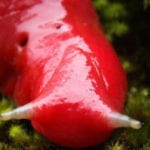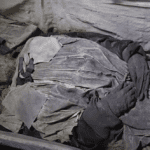 Technology
Technology  Technology
Technology  Humans
Humans 10 Everyday Human Behaviors That Are Actually Survival Instincts
 Animals
Animals 10 Animals That Humiliated and Harmed Historical Leaders
 History
History 10 Most Influential Protests in Modern History
 Creepy
Creepy 10 More Representations of Death from Myth, Legend, and Folktale
 Technology
Technology 10 Scientific Breakthroughs of 2025 That’ll Change Everything
 Our World
Our World 10 Ways Icelandic Culture Makes Other Countries Look Boring
 Misconceptions
Misconceptions 10 Common Misconceptions About the Victorian Era
 Mysteries
Mysteries 10 Strange Unexplained Mysteries of 2025
 Miscellaneous
Miscellaneous 10 of History’s Most Bell-Ringing Finishing Moves
 Technology
Technology Top 10 Everyday Tech Buzzwords That Hide a Darker Past
 Humans
Humans 10 Everyday Human Behaviors That Are Actually Survival Instincts
 Animals
Animals 10 Animals That Humiliated and Harmed Historical Leaders
Who's Behind Listverse?

Jamie Frater
Head Editor
Jamie founded Listverse due to an insatiable desire to share fascinating, obscure, and bizarre facts. He has been a guest speaker on numerous national radio and television stations and is a five time published author.
More About Us History
History 10 Most Influential Protests in Modern History
 Creepy
Creepy 10 More Representations of Death from Myth, Legend, and Folktale
 Technology
Technology 10 Scientific Breakthroughs of 2025 That’ll Change Everything
 Our World
Our World 10 Ways Icelandic Culture Makes Other Countries Look Boring
 Misconceptions
Misconceptions 10 Common Misconceptions About the Victorian Era
 Mysteries
Mysteries 10 Strange Unexplained Mysteries of 2025
 Miscellaneous
Miscellaneous 10 of History’s Most Bell-Ringing Finishing Moves
10 Strange Stories About Wine
Benjamin Franklin once famously declared that wine is “constant proof that God loves us and loves to see us happy.” Without a doubt, wine is one of the most beloved beverages of all time, popping up in Christian rituals, pagan celebrations, ritzy restaurants, and Paul Giamatti movies. And as it dates back around 8,000 years, wine has acquired enough strange facts and crazy stories to make a sommelier’s head start spinning.
10 Red Wine Might Not Be All That Good For You
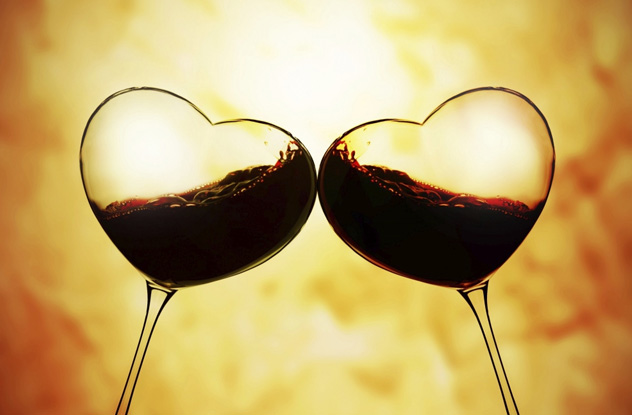
Ever heard of the French Paradox? The term describes the weird way that the French eat so much fatty food yet suffer from barely any heart disease. For a long time, scientists believed that red wine was the key to French longevity. One of wine’s ingredients is a polyphenol called resveratrol, and researchers claimed that this antioxidant fights all manner of ills, like heart disease, cancer, and inflammation.
It’s possible, however, that we overhyped this resveratrol business. Earlier in 2014, scientists from the Johns Hopkins University School of Medicine published a study suggesting resveratrol isn’t all that special.
Between 1998 and 2009, researchers followed nearly 800 villagers from two Italian towns. The subjects were all 65 and over, and they all drank a moderate amount of red wine. None of the subjects lived exceptionally long lives. In fact, 268 of them died, 174 were stricken with heart disease, and 34 got cancer. We may have to look further to solve the mystery of the French Paradox.
9 Thank Wasps For Wine
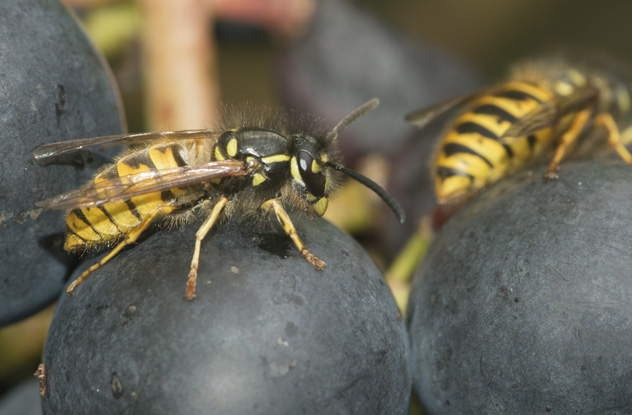
No one likes wasps. They’re hypodermic needles with wings and an attitude. But despite their habit of stinging you for absolutely no reason, we all owe the wonders of wine to these bad-tempered bugs.
During the summer, the fungus Saccharomyces cerevisiae grows on vineyard grapes, and this particular yeast is key in making wine, beer, and bread. Sure, winemakers add even more yeast later, but if S. cerevisiae isn’t present on the grapes from the start, the wine just won’t have the same taste. However, there’s one little problem. S. cerevisiae only grows during the summer. The winter chill should kill all the fungi off.
That’s where the wasps come in. Wasps love grapes. When the fruits ripen in the summer, the bugs chow down and fly back to their nests, where they give the masticated mush to their larvae.
When they eat the fruit, the insects ingest the yeast, and their stomachs provide the perfect environment for it to survive the frosty months. More importantly, when wasps feed their young, they pass the fungus to their babies. That way, when the larvae mature, they reintroduce S. cerevisiae to the vineyards and start the process all over again.
8 The Reason We Clink Wine Glasses
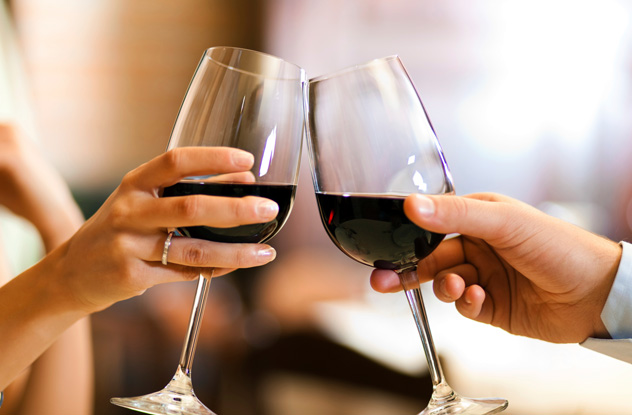
Clinking wine glasses is one of those time-honored traditions we perform without even thinking. Some claim it was originally meant to drive away demons. Others believe the idea was to slosh a little bit of wine into your drinking partner’s glass—that way, he couldn’t poison you without risking dying himself.
As exciting as those theories are, they’re just not true. The real reasons we touch our glasses are much simpler.
Back before clinking was invented, a toast involved four senses: touch, taste, sight, and smell. The ears were left out of the equation. But as the manufacturing of wine glasses transformed into an art, people began appreciating the fine sounds of struck stemware, and voila, the clink was incorporated into the toasting routine.
Clinking also produces a sense of community. Back in olden days, partygoers would pass around a single bowl of wine, and everyone shared from this single vessel. (After the bowl worked its way around the circle, the host would eat a piece of cooked bread, a literal toast.) Today, we’re a bit too worried about germs to try that, so instead of drinking after our neighbors, we tap our glasses. It’s a way of saying, “Hey, I’m part of the group and sharing in the good feeling.”
7 The Judgment Of Paris

We often associate certain countries with particular products. For example, say “chocolate,” and you immediately think Belgium. Mention watches, and you automatically picture Switzerland. And for most of the 20th century, wine was synonymous with France. But all that changed in the spring of 1976, when French and American winemakers went head to head in the greatest underdog story in the oenological world.
Later dubbed “The Judgment of Paris” after a story from Greek mythology, this Dionysian showdown was run by British wine merchant Steven Spurrier. Taking advantage of the US bicentennial, Spurrier decided to pit world-renowned French wines against up-and-coming California wines in a winner-takes-all contest. The drinks were judged by a panel of respected wine critics such as the editor of France’s premier wine magazine and the dean of French culinary writers.
The odds were not in the Americans’ favor. Pretty much everyone expected the French to clean house, but when the white wines were judged after a blind tasting, California won three out of four top spots.
People were stunned, and Steven Spurrier suddenly feared that the French might lose the much more prestigious red competition as well. So (in total violation of the rules), he told the judges the results of the white test before the official announcement. Knowing the reputation of French vineyards was on the line, some judges tried their hardest to make sure the Americans lost. Despite this, the panel chose a California Cabernet as the number one red wine in the world.
Humiliated, the French hoped the story would silently disappear, but journalist George Taber covered the incident in Time magazine, sending shock waves across the culinary world and changing the California wine industry forever.
6 Wine Tasters Are Easily Fooled
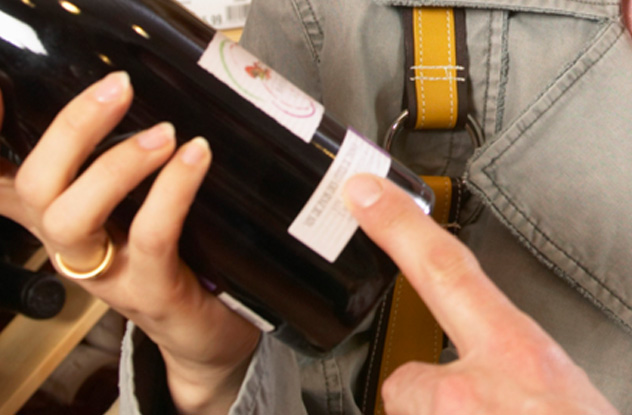
Earning the position of sommelier is quite a culinary achievement. It takes a lot of time, practice, and cultivation of the senses, and you have to learn a lot of complicated concepts like “connectedness” and “soil quality.” But wine critics are just people, and they can be fooled like anybody else.
In 2001, a researcher at the University of Bordeaux ran a test on 54 oenology students (oenology is the study of wine). The researcher offered the students two glasses of wine, one red and one white. After taking a sip, the subjects were asked to describe the taste of each wine, and they all described the different grapes and tannins they could taste in each glass. Only they weren’t drinking red wine. The researcher had secretly dyed a bottle of white wine red, successfully fooling all of the students.
A similar test took place at the California Institute of Technology. Researchers put cheap wine into expensive bottles and expensive wine into cheap bottles. The drinkers weren’t just fooled into claiming the cheap wine tasted better—scans actually revealed more involuntary brain activity when they drank the allegedly expensive stuff.
These psychological quirks can cost wine fans a pretty penny. A researcher at Brock University learned people are willing to pay $2 extra per bottle if the wine has a name that’s hard to pronounce, regardless of the taste. And for eight years, an Indonesian con man named Rudy Kurniawan earned at least $1.3 million on counterfeit wine just by telling people his wine was older than it was.
5 Music Affects The Taste Of Wine
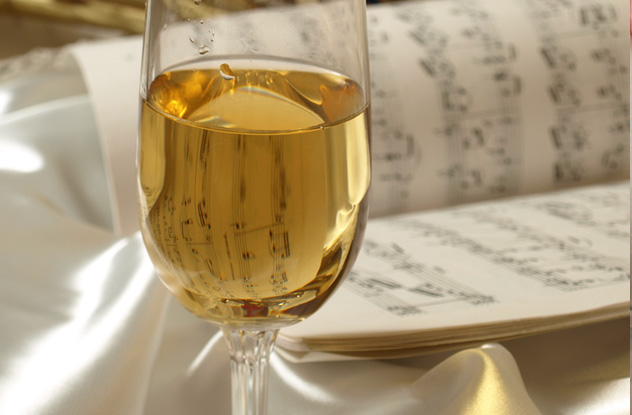
As part of an experiment, researcher Adrian North from Heriot Watt University asked a test audience to separate several songs into specific categories. The music could be classified as “powerful and heavy,” “subtle and refined,” “zingy and refreshing,” or “mellow and fresh.”
In Phase Two, North had a second set of 250 test subjects drink either a Cabernet Sauvignon or a Chardonnay while listening to the previously classified music. (A control group, meanwhile, drank wine without anything playing in the background.) Some sipped their drink while listening to Tchaikovsky’s “Waltz of the Flowers” (subtle and refined); others savored their wine to Michael Brook’s “Slow Breakdown” (mellow and soft). After the taste test, subjects were asked to group the wines into one of the previously mentioned categories.
By the time North was finished, he’d discovered that music has a powerful impact on the way we perceive wine. For example, when people drank red wine while listening to Carl Off’s booming “Carmina Burana,” 60 percent of the subjects described their drink as “powerful and heavy.” A comparably large percentage of test subjects rated the same wine as “zingy and refreshing” when listening to Nouvelle Vague’s “Just Can’t Get Enough.”
So the next time you visit a restaurant and order a drink, pay close attention to the background music. It might totally change whatever’s in your glass.
4 Tiger Bone Wine
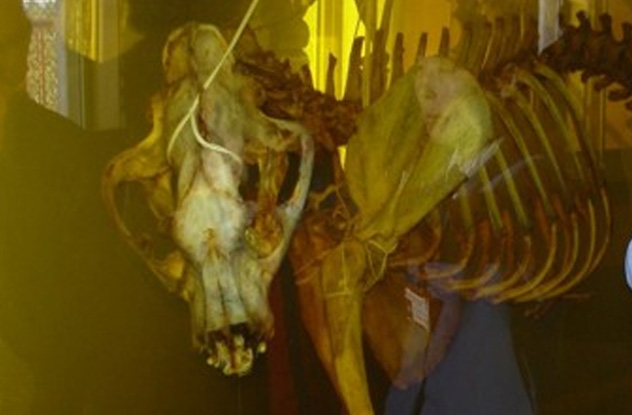
The world of wine is a weird and wacky place, full of wild potions. Take meteorite wine, for example. Bottled in 2012, this stuff was slowly aged with a space rock that crashed to earth around 6,000 years ago. Supposedly, the meteorite gives the wine a “livelier taste.”
And then there are the bizarre wines made from non-grape fruits and grains, like rice. On the tame side, we have Omerto, a Canadian wine made of fermented tomatoes. On the incredibly bizarre side, there’s the ever popular three penis wine, a Chinese concoction made with the genitalia of dogs, seals, and deer. Topping our list of weird wines is the uber-obscure and extremely controversial ttongsul, a little-known Korean wine allegedly made of human feces.
But the saddest of all is tiger bone wine, another Chinese confection, a beverage requiring endangered animals. The recipe involves soaking tiger bones in a vat of rice wine, and a bottle can go for over $800. A whole crate can sell for around $30,000.
While tiger bone wine has been illegal since 1993, the stuff is still wildly popular. Supposedly, this outlaw brew can cure arthritis and chills, improve qi, and give consumers the “sense of a predator.” Perhaps more significantly, tiger bone wine is a status symbol. If you can afford a bottle, it means you’re a wealthy, important person.
While authorities occasionally shut down auctions selling tiger bone wine, sellers find loopholes around laws by pointing out the wine doesn’t actually contain any tiger parts once it’s bottled.
3 The Romanee-Conti Poisoning Affair
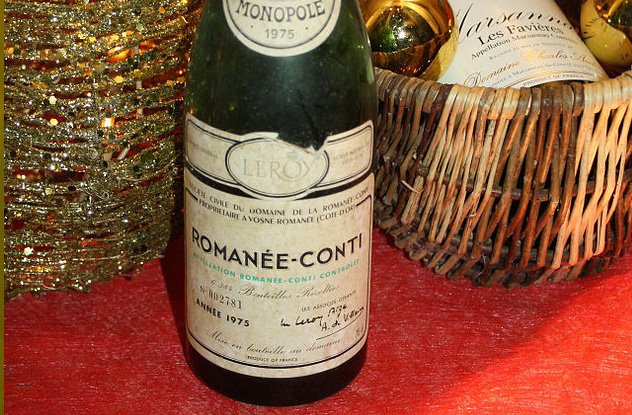
Romanee-Conti is one of those luxury foods that’ll break your bank. The average bottle runs between $900 and $1,000, and a case of the stuff—vintage 1978—sold for a whopping $476,280 in 1993. With such staggering prices, the folks at Romanee-Conti wouldn’t want anything to happen to their vineyards. So when they received a letter threatening to poison their plants, they were understandably worried.
In January 2010, Romanee-Conti co-owner Aubret de Villaine received a map of his Burgundy vineyards and a letter demanding $1.27 million. According to the map, the crook had already poisoned two of his vines and would attack further unless the ransom was paid. The blackmailer demanded someone stuff the cash in a suitcase and meet him in a nearby graveyard at night.
Police set up camp around the cemetery, and a Romanee-Conti representative dropped off a case full of paper. Authorities nabbed the crook as soon as he showed up. The blackmailer was named Jacques Soltys and had got his crazy scheme from a cellmate in prison. Perhaps this time around, he won’t pay so much attention to his roommates.
2 Wine In Space
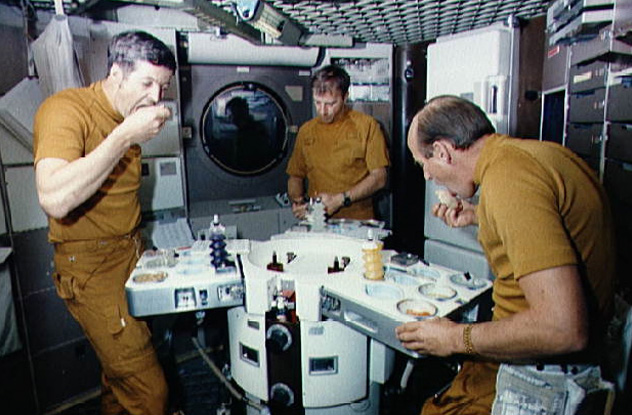
In 1969, a small vial of wine boldly went where no beverage had gone before. Buzz Aldrin, a religious man, held communion on the Moon, complete with a small wafer and a bit of fermented grape juice. But that wasn’t the last time someone tried to send wine up among the stars.
In the 1970s, NASA was trying to figure out how to make space flight more comfortable for its astronauts. One of their best ideas was to improve the quality of space food. Instead of dried chunks of inedible powder, they started adding frozen foods, wet-packed meals, and perishables to the menu. Soon, astronauts would enjoy delicacies like spaghetti and prime rib—and even a little alcohol.
Enter Charles Bourland, the man in charge of choosing wine for the Apollo program. Not only did he have to find something tasty, he needed a wine that could stand up to the rigors of space travel. Since NASA couldn’t load a rocket with heavy, clunky bottles, Bourland needed to find a wine that wouldn’t lose its flavor after repackaging. Working with researchers at the University of California, Bourland finally decided upon sherry. Sherry, a fortified wine, is heated during processing. This stabilizes it, so it is unlikely to change after leaving the bottle.
The sherry was poured into a special plastic bag with a built-in straw. All astronauts had to do was squeeze the pouch, and they could enjoy a nice sip of wine. Yet the plan didn’t exactly pan out.
When the public learned of the plan, teetotalers around the nation rose up in righteous anger, convincing NASA to pull the plug on the sherry experiment. It also turned out that wine, in zero-gravity, released an unpleasant odor, and it seemed unwise to add unnecessary nausea to the astronauts’ many problems.
The sherry didn’t go to waste. While the wine didn’t end up in outer space, it did end up as part of the SMEAT (Skylab Medical Experiment Altitude Test) program, a test involving a group of astronauts locked inside a vacuum chamber for 56 days. They probably had a really good time.
1 The Jefferson Bottles And The Atomic Bomb
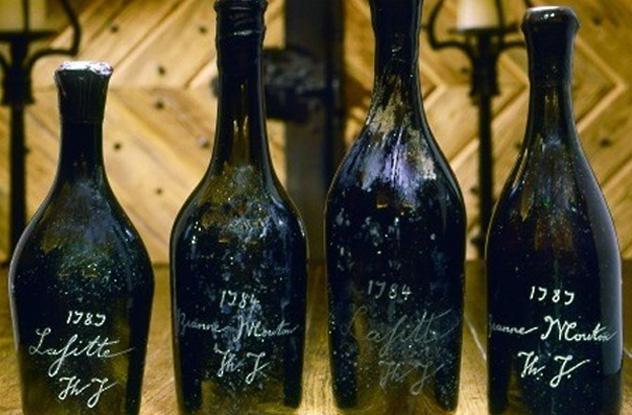
This strange saga began in the late ’80s, when billionaire William Koch bought four bottles of wine for $500,000. The bottles came from a collection owned by Hardy Rodenstock, a big name in the German music scene, who claimed he’d discovered them in a hidden Parisian cellar. Most of the bottles dated back to 1787, said Rodenstock, and they happened to once belong to the third President of the United States.
It seemed plausible that the bottles were Thomas Jefferson’s. The man was quite the oenophile. Not only did he keep detailed descriptions of various French wines, he even supplied George Washington with the very best stuff. But when the Museum of Fine Arts in Boston was getting ready to display Koch’s collection of wines, they learned some disturbing news. According to the folks at Monticello (who possessed Jefferson’s oenological notes), the ex-president had never purchased that particular kind of wine. Suddenly, it looked like Hardy Rodenstock had conned Bill Koch.
Wanting to know if he’d been duped, Koch hired former FBI agent Jim Elroy to investigate the Jefferson bottles. Elroy put together a crack team of super sleuths that included experts from Scotland Yard and MI5, and the group started digging around, trying to find proof of the wine’s vintage. The trick was doing it in such a way that they didn’t have to open the bottles and ruin the contents. That’s when they learned about a French physicist named Philippe Hubert, a man who could determine the age of wine—thanks to the atomic bomb.
When the first atomic bombs went off in the 1940s, they unleashed a totally new radioactive isotope called cesium-137. Before 1945, cesium-137 simply didn’t exist, but today, it’s everywhere. It’s even inside of you right now, and if Hubert could prove there was cesium-137 inside the wine, he would know in was bottled post-1945.
So the scientist took the bottles into his laboratory under the Alps and placed them beside a gamma ray detector, specially covered in lead smelted by the ancient Romans. These precautions sought to shield the detector from outside radiation.
There wasn’t any cesium-137 to be found. The wine had been bottled before 1945.
However, the story wasn’t over yet. Jim Elroy and his team discovered something odd about the bottles themselves. Each one was graved with the initials “Th.J,” which obviously stood for “Thomas Jefferson.” After extensive investigation, the team discovered the letters had been engraved with an electric dentistry tool.
With evidence in hand, Bill Koch launched eight lawsuits against Hardy Rodenstock and his cohorts. The suits cost the billionaire at least $25 million, but he managed to recoup some of his losses when the courts awarded him $12 million in damages.
Nolan Moore would like to raise his glass to all the good people reading this list. Cheers. If you want to keep up with Nolan’s writing, you can friend/follow him on Facebook, or if you want, you can email him here.



